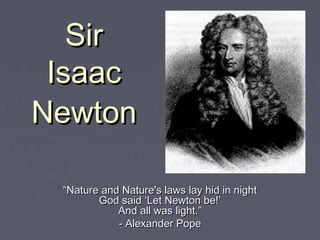
Newton
- 1. SirSir IsaacIsaac ““Nature and Nature's laws lay hid in nightNature and Nature's laws lay hid in night God said ‘Let Newton be!’God said ‘Let Newton be!’ And all was light.”And all was light.” - Alexander Pope- Alexander Pope NewtonNewton
- 2. Early LifeEarly Life ► Born on December 25,Born on December 25, 1642 (January 4,1642 (January 4, 1643) in Woolsthorpe,1643) in Woolsthorpe, Lincolnshire, EnglandLincolnshire, England ► Raised by hisRaised by his grandparentsgrandparents ► Pulled out of school atPulled out of school at 14 to run the family14 to run the family farmfarm ► Wasn’t good atWasn’t good at farming, so they sentfarming, so they sent him back to schoolhim back to school
- 3. EducationEducation ► Entered Trinity CollegeEntered Trinity College at Cambridge Universityat Cambridge University at age 18 and beganat age 18 and began studying to become astudying to become a ministerminister ► Graduated at age 23Graduated at age 23 ► Returned to the farmReturned to the farm because of the Blackbecause of the Black DeathDeath He got bored and endedHe got bored and ended up working on theup working on the binomial theorem, light,binomial theorem, light, telescopes, calculus, andtelescopes, calculus, and theologytheology Newton in about 1702
- 4. CalculusCalculus ► Started developing Calculus asStarted developing Calculus as early as 1666 but never reallyearly as 1666 but never really got around to publishing muchgot around to publishing much ► In about 1668, Wilhelm LeibnizIn about 1668, Wilhelm Leibniz began developing very similarbegan developing very similar ideas and published themideas and published them before Newton has publishedbefore Newton has published his workhis work ► (Leibniz used dy/dx notation;(Leibniz used dy/dx notation; Newton used )ẏNewton used )ẏ Post-Modern Newton
- 5. ““Opticks”Opticks” ► Discovered that light is madeDiscovered that light is made up of a spectrum of colorsup of a spectrum of colors ► Made the first telescope thatMade the first telescope that used a curved mirror instead ofused a curved mirror instead of lenseslenses ► Believed that light was madeBelieved that light was made up of “corpuscles” rather thanup of “corpuscles” rather than waves (Hooke and Huygenswaves (Hooke and Huygens disagreed)disagreed) ► Didn’t publish any of this untilDidn’t publish any of this until the after the death of Hooke inthe after the death of Hooke in 17031703 Newton in the Lab
- 7. Apples and StuffApples and Stuff ► FormulatedFormulated Newton’s LawsNewton’s Laws ► Proved that the forceProved that the force of gravity is inverselyof gravity is inversely proportional toproportional to distance squareddistance squared ► After conqueringAfter conquering gravity, motion andgravity, motion and optics, decided tooptics, decided to work on changingwork on changing lead into goldlead into gold
- 8. Religious ViewsReligious Views ► Wrote a book about the fall ofWrote a book about the fall of Christianity in the 4Christianity in the 4thth Century A.D.Century A.D. ► ““This most beautiful system of theThis most beautiful system of the sun, planets, and comets, couldsun, planets, and comets, could only proceed from the counsel andonly proceed from the counsel and dominion of an intelligent Being ...dominion of an intelligent Being ... This Being governs all things ... asThis Being governs all things ... as Lord of all. . . Atheism is soLord of all. . . Atheism is so senseless. When I look at the solarsenseless. When I look at the solar system, I see the earth at the rightsystem, I see the earth at the right distance from the sun to receivedistance from the sun to receive the proper amounts of heat andthe proper amounts of heat and light. This did not happen bylight. This did not happen by chance.”chance.” ► His religious ideas got him inHis religious ideas got him in trouble because he taught at atrouble because he taught at a church-run universitychurch-run university
- 9. Newtonian TriviaNewtonian Trivia ► Became Master of theBecame Master of the Royal Mint in 1699Royal Mint in 1699 ► First scientist to beFirst scientist to be knighted for his workknighted for his work (1708)(1708) ► Elected President of theElected President of the Royal Society every yearRoyal Society every year from 1703 to 1727from 1703 to 1727 ► Member of ParliamentMember of Parliament (1689-1690)(1689-1690) ► Died in 1727Died in 1727 Newton in 1726
- 10. ““If I have ever made any valuable discoveries, it hasIf I have ever made any valuable discoveries, it has been owing more to patient attention, than to anybeen owing more to patient attention, than to any other talent.”other talent.” -Sir Isaac Newton-Sir Isaac Newton
Editor's Notes
- A replica of Isaac Newton's telescope of 1672. This was a new design of telescope - the Newtonian reflector. At 6 inches in diameter, it was also one of the largest telescope of its day. Newton's work on optics and splitting white light, led him to believe that all refracting telescopes would suffer from chromatic aberration. His new design of reflecting telescope minimised this problem. However, due to problems with accurately grinding the mirror, Newton's telescope actually caused more image distortions than other contemporary telescope and more than a century passed before reflecting telescope became popular. Newton presented the original telescope to the Royal Society in 1672 and was admitted as a fellow of the society in the same year. This replica is in the the Whipple Museum of the History of Science in Cambridge.
